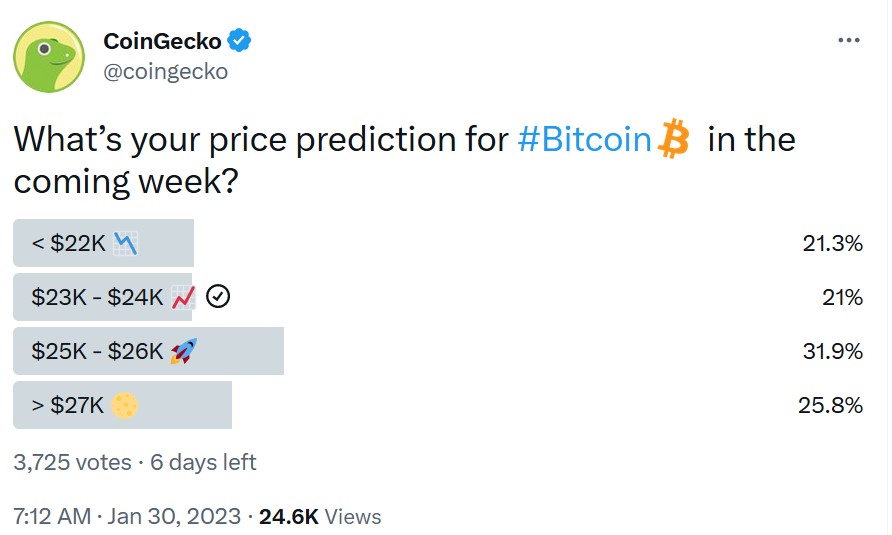Bitcoin stays out of fear for 11 straight days as price tips near 24K


Bitcoin’s huge price surge in January has meant that 64% of Bitcoin investors are in profit, according to data from IntoTheBlock.
Bitcoin (BTC) has just clocked its 11th consecutive day outside the “Fear” zone in the Crypto Fear and Greed Index, cementing its longest streak out of fear since last March.
Bitcoin Fear and Greed Index is 61 – Greed
Current price: $23,780 pic.twitter.com/U5gxN3AwnT— Bitcoin Fear and Greed Index (@BitcoinFear) January 30, 2023
This comes as Bitcoin hit $23,955 at 8:10 pm UTC time on Jan. 29, its highest level of the year. It has since come back down slightly, to $23,687 at the time of writing.
Meanwhile, Bitcoin sentiment is currently sitting firmly in the “Greed” zone with a score of 61, its highest level since the height of the bull run around Nov. 16, 2021, when its price was about $65,000.


However, despite Bitcoin’s strong resurgence in recent weeks, market participants continue to debate whether the recent price surge is part of a bull trap or whether there is a real chance for a bull run.
Regardless, the current rally has pushed a lot more BTC holders back into the green.
According to data from blockchain intelligence platform IntoTheBlock, 64% of Bitcoin investors are now in profit.
Those who first bought BTC back in 2019 are now — on average — back in profit too, according to on-chain analytics platform Glassnode.
We can calculate the average acquisition price for #Bitcoin by tracking exchange withdrawals.
The chart below shows the average withdrawal price for investors for each year.
The average class of 2019+ $BTC is now back in profit (at $21.8k)
Live Chart: https://t.co/yuhvydV70c pic.twitter.com/skjrM6w5lH
— glassnode (@glassnode) January 29, 2023
The average first-time buy price for BTC investors in 2019 was $21,800, which means those investors are on average up about 9% at the Jan. 29 price of $23,687.
Related: Bitcoin eyes $25K as BTC price nears best weekly close in 5 months
Meanwhile, a Jan. 29 poll from crypto market platform CoinGecko has revealed that 57.7% of 3,725 voters believe BTC will exceed $25,000 this week, while only 21.2% of voters believe BTC is primed for a pullback below $22,000.


The founder and CEO of Vailshire Capital, Dr. Jeff Ross, also provided a technical analysis of his own on Jan. 29, suggesting that a price surge toward $25,000 in the short term may be on the cards:
The strength of #bitcoin on the 4-hour charts continues to be impressive.
While price action has trended sideways for over a week, short term indicators (MACD, RSI) have once again reset… and are now ramping higher.
A price surge to ~$25k is probable.
(Not investment advice) pic.twitter.com/QaPbNrxtxZ
— Dr. Jeff Ross (@VailshireCap) January 29, 2023
Other analysts have called for excited investors to taper some of their expectations, however.
Head analyst Joe Burnett of Bitcoin mining company Blockware told his 43,900 Twitter followers on Jan. 29 that BTC won’t reach and surpass its all-time high of $69,000 until after the next Bitcoin halving event, which is expected to take place in March 2024:
I do not think Bitcoin will make a new all time high until after the 2024 halving.
Dovish macro conditions and decreased miner sell pressure will lead to the next parabolic bull run.
Using Energy Gravity as a potential top indicator, I expect the next peak to be $150k – $350k. pic.twitter.com/OfCER7s8Zq
— Joe Burnett ()³ (@IIICapital) January 29, 2023
Macroeconomist and investment adviser Lyn Alden also recently told Cointelegraph that there may be “considerable danger ahead” with potentially risky liquidity conditions expected to shake the market in the second half of 2023.











